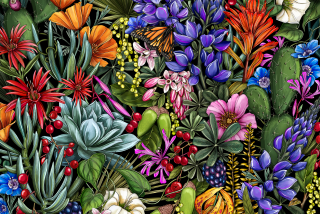Earn a Macadamic Degree in Planting Nut Trees
- Share via
Mention macadamia nuts and most people think of Hawaii, which is something Tom Cooper wants to stop. Instead, the Fallbrook macadamia nut farmer would like you to think of your backyard.
“Many people don’t realize that in Southern California, we can grow macadamia nuts that are even better than those grown in Hawaii,” says the owner of Cooper’s Nut House, where they sell macadamia nut trees and farm, process and sell nuts.
Macadamia nuts aren’t even from Hawaii. Native to Australia, they were introduced to California and Hawaii in 1888.
“Five of those original trees are still thriving and producing in various areas of Southern California,” says Cooper.
Though we grow different varieties than they do in Hawaii, macadamia nuts grown here are extremely tasty, and the trees are easy to grow, says Eunice Messner of Anaheim Hills, a member of the California Rare Fruit Growers and the Orange County Rare Fruit Growers and a contributing editor to The Fruit Gardener Magazine.
Macadamia nut trees are also attractive landscape additions, says Messner. “They flower this time of year with pretty, long, pink, tassel-like blooms that stay on the tree for about a month, after which the nuts form.”
Macadamia trees generally grow to about 25 to 30 feet tall and 15 to 20 feet wide. They bloom now and will bear next winter through early spring. They can be planted at any time of year, although spring and fall, when the weather is mild, are the best planting times.
There are several varieties available for home growing. One old-time favorite that does well in the backyard is the ‘Beaumont,’ which can bloom several times throughout the year but has its biggest bloom now. Messner likes it for the home garden because it drops its nuts intermittently.
There is only one drawback to the ‘Beaumont,’ says Alva Snider, emeritus director of the California Macadamia Society and a Fallbrook macadamia nut grower with 100 trees, who sells through a co-op of more than 80 small growers.
“ ‘Beaumont’ nuts sometimes split on the tree, which leads to a bitter flavor in the nut,” he says. “All you have to do, however, is remove the brown part on the nut.”
Another variety sometimes grown in the home garden is ‘Cate,’ which tends to have a thinner shell than other types and bears for a short period. Other varieties suggested by Cooper include ‘Cannon,’ with a medium-thick shell and large nut, ‘Carmel,’ an even larger nut, and ‘James,’ a thick-shelled nut with a good flavor.
To have the best luck growing macadamia trees, keep the following tips in mind:
* Choose a sunny site that drains well. The current trend when planting a tree is not to add amendments, but to work the soil well, plant and then mulch on the surface. If, however, your soil is heavy clay and you need to improve drainage, add 10% to 20% pumice and the soil conditioners gypsite or gypsum, according to package directions. Because trees tend to settle after planting, plant the tree about an inch higher than it was in the pot.
* Provide constant moisture. Macadamia nuts are tropical trees that need a lot of water, says Snider. “It’s important that the top 6 to 8 inches of soil where the feeder roots are stays moist,” he says. In general, they require about six gallons of water a day and should be watered every one to two days, depending on the weather and soil type, says Cooper. Sandy soil will need more frequent watering than clay.
* Mulching will keep the soil moist and provide the tree with nutrients as it breaks down. If possible, grind up the tree droppings and use as mulch or apply bagged compost.
* Macadamia nuts aren’t heavy feeders. Cooper doesn’t use fertilizer, relying on the nutrients in the mulch instead. Snider applies a well-balanced fertilizer twice a year, and Messner uses chicken compost biennially and a foliar spray of seaweed and sea kelp each spring.
* Once established, macadamia nuts don’t need much pruning. Trim when shaping is necessary. Cooper suggests training young trees by pruning so that the tree has one basic single trunk with limbs radiating from that trunk. This will help prevent a blow-over during winds. Pruning should be done after harvesting.
* Some macadamia trees drop their nuts when they are ready, while others, like the ‘Beaumont,’ must be stripped. After harvesting, remove the husk from each nut, which will expose the hard brown shell, inside of which is the nut meat.
Dry the nuts while still in the shell. Snider suggests air-drying them for 10 days to two weeks outdoors in the shade and then placing them in an oven at 110 to 115 degrees for about two days. You can’t over dry them, and the drier they are, the longer they will store without becoming rancid. Once dry, you can remove the shell, which is best done with a macadamia nut cracker, as the shell is very hard.
* Watch for rodents. Macadamia nut trees are rarely bothered by pests, but their fruit attracts rats, squirrels and mice. Contact county vector control regarding baiting or trapping.
Macadamia Resources
* Cooper’s Nut House carries trees, nuts and nut crackers on a retail and mail-order basis. They also dry and crack nuts for a fee. 1378 Willow Glen Road, Fallbrook. Open daily, 8 a.m.-6 p.m. (760) 728-6407 or https://www.coopersnuthouse.com.
* The California Macadamia Society, which formed in 1955, instructs members on how to grow and use macadamia nuts. Annual dues are $17.50 and include a newsletter, yearbook, annual meeting and field trip. P.O. Box 1298, Fallbrook 92088. (760) 728-8081 or https://users.aol.com/TeeterJS/cms.
* The Orange County Rare Fruit Growers meets the third Thursday of the month at 7:30 p.m. at the Orange County Fairgrounds, Centennial Farm silo building, Costa Mesa. Use main entrance on Fair Drive.




